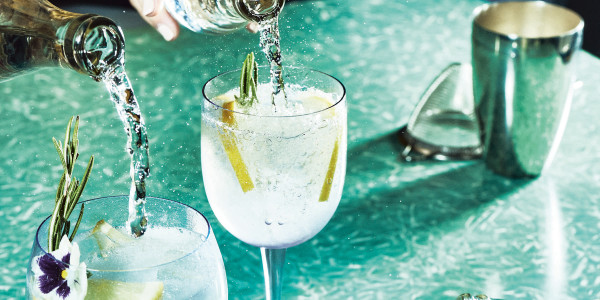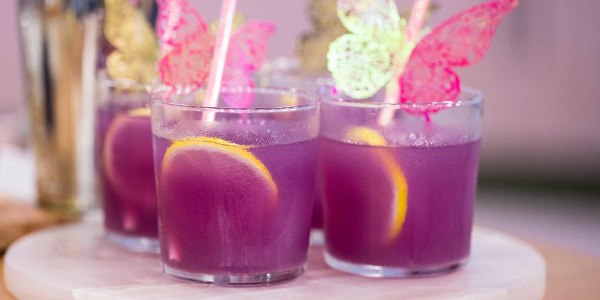Hot on the heels of “girl dinner,” pickles in a blanket and feta fried eggs, our stomachs are now set on the trendy ingredients, flavors and gastronomical experiences that will shape 2024. We’re sure the new year will bring the absurd, the delicious and the absurdly delicious, but many fads speak to overarching themes like sustainability, the state of our economy and access to produce that may or may not have been farmed on a global scale.
To provide more insight on what the future holds, we spoke to dozens of chefs from around the world to speak to six food and drink themes that are sure to be the rage in the coming year.
Super spicy condiments
Gone are the days of notoriously picky kids refusing to try more adventurous dishes. Gen Z has ushered in a willingness to sample new ingredients, especially when it comes to all things spicy (and swicy). And while fiery condiments like Sriracha, chili oil and hot sauce are certainly here for the long run, expect these beloved concoctions to be integrated more frequently and creatively in mainstream cuisine.
Examples will include painfully piquant ramen, African-inspired chili oils and pepper-infused spirits.
“The thrill of heat is not just about setting taste buds on fire; it’s about the complexity and depth that fiery elements can bring to a dish or cocktail,” says Hicham El Ibrik, complex director of food and beverage for Islamorada Resort Collection, who recently introduced a zesty lobster arrabbiata at his Reel Catch restaurant in Amara Cay, Florida.
“I believe fermented, spiced sauces will continue to be a condiment people crave; they always deliver big on flavor,” adds Gareth Mullins, executive chef of Anantara The Marker Dublin Hotel. “Gochujang (Korean red chili paste) is a staple in my pantry for its robust flavor and delicious taste.”
Innovative plant-based cuisine
A rise in veganism and vegetarianism, as well as a general public desire to eat more plant-based food, isn’t just a foray into proactive health consciousness — it’s also a response to the environmental concerns of livestock farming. But we’re no longer limited to protein sources like tofu, beans and lentils. Instead, chefs have become more innovative in their approach to plant-based eating, using vegetables in more creative ways to land them in the starring role of your plate.
“The evolution of plant-based foods is fascinating, particularly with innovations like mushroom root steaks,” confirms Wojciech Popow, executive development chef of Beaverbrook in Surrey, U.K. “Mushrooms offer a unique texture and umami flavor that can mimic meat, appealing to vegetarians and meat-eaters alike.”
Vjay Veena, executive chef of The Setai in Miami Beach, echoes this sentiment, but also predicts that stem vegetables like okra, corn, eggplant, green beans and edamame will “be huge as well.”
But when it comes to seafood, here is where ingenuity on the plate really gets a chance to shine, like the taro-based “scallop” at Prince Waikiki’s 100 Sails restaurant in Honolulu, Hawaii.
“Plant-based seafood has become popular due to decreasing numbers of productivity, which has skyrocketed fish prices,” says Yulissa Acosta, chef de cuisine at Hearth ‘61 at Mountain Shadows Resort Scottsdale. “Seaweed, soy and different types of starches are being utilized in certain restaurants to replace the fish on their menu, and I believe the demand will increase for 2024.”
That said, it’s important to not always see plants as a “meat replacement” and to celebrate the textures and flavors in their original forms.
“Plant-based products no longer have to look and taste like animal products, and can instead be something entirely their own,” stresses Carsten Kyster, executive chef of plant-based Shades of Green at the Soneva Fushi resort in Maldives. “A beetroot is a beetroot in the plant-based universe and we showcase the best of what it can be in our beetroot tartare.”
Nonalcoholic spirits and wine
The concept of mocktails and zero-proof drinks is far from novel, but the nonalcoholic beverage industry will continue to extend beyond an ordered glass at a bar or restaurant.
Entire bottles of spirit-inspired blends are anticipated to dominate liquor store shelves, as well as canned nonalcoholic wines, spritzes and seltzers. This trend will also extend into fine dining with tastings that incorporate innovative, nonalcoholic sippers to complement each course.
“The rise of nonalcoholic pairings, whether it’s with exquisite teas or artfully crafted juices, signifies a refreshing evolution in the world of culinary experiences, where the harmony of flavors extends to those who seek a vibrant, alcohol-free journey through their dining adventures,” says Laurent Gardinier, president of Relais & Châteaux in France.
“Our resort will expand its cocktail and mocktail offerings in 2024, which will incorporate regional herbal and floral elements like jasmine, yucca and Indian paintbrush,” adds Marissa Valdez, director of food and beverage at ULUM in Moab, Utah. “There will also be fun transitional elements such as fruit- and chocolate-infused ice cubes that change the flavor of the drink as it melts.”
Kevin Zapf, owner of alcohol-free speakeasy Bandbox Orlando, also predicts a rise in mocktail innovation, but claims that it will focus more on the integration of specific ingredients rather than just the lack of alcohol.
“The trend is now pushing further into more CBD or THC-based beverages,” he shares. “Another portion of the market is also expanding into kava and kratom-based drinks and seltzers as well.”
Little luxuries
“Treat yourself” may be a phrase plucked directly from an iconic episode of “Parks and Recreation,” but its significance is more important now than ever before.
As the stresses of a struggling economy, wars and pandemic have taken their toll on our mental health, many people are turning to single-serving culinary indulgences to get them through another day. This trend also allows for consumers to afford smaller-portioned, typically unattainable luxury items like tinned fish and caviar, rather than shelling out hundreds of dollars on products that could go to waste if not served on a special occasion and/or to a larger group of people.
“As we embrace 2024, the culinary world is witnessing a transformative trend: mindful indulgence,” reaffirms Wilfried Bergerjausen, culinary director of RMD Group in San Diego. “This concept transcends mere dining; it’s about celebrating affordable luxury, where the simplicity of daily meals is elevated to gourmet heights through creativity and conscientious care.”
“Consumers are increasingly drawn to meaningful, budget-friendly culinary delights that connect them with cultural stories and traditions,” he adds, noting that the popularity of koji — mold-inoculated rice, barley or soybeans from Japanese cuisine — is a perfect example. “It emphasizes intentional food choices, preferring quality over quantity, and connecting with the stories behind our meals. Koji, with its rich heritage and profound impact on flavors, embodies the spirit of mindful indulgence, reminding us that extraordinary experiences often originate from the simplest of ingredients.”
Tried-and-true staples of opulence like caviar, however, will continue to have a moment, both in restaurants and on pantry shelves.
“There is a ‘caviar renaissance’ happening at the moment, tied to its availability, affordability, service and types of presentation we’re seeing used across the board,” says Francisco Lopez Jr., executive chef at MacArthur Place. “It is (also) being presented in new ways, such as inside of waffles, as chips and dip, or on top of savory French toast.”
Snacks for dinner
Grazing and charcuterie boards aren’t going anywhere anytime soon. And while we may scoff at the gendered idea of “girl dinner” (which typically includes cheese, crackers, nuts and deli meats), noshing in place of a full meal provides a sense of exploration and customization that may be more limited by straightforward, easy-to-make dishes. It’s also an easy way to use up and reimagine leftovers by placing a variety of these bites on one serving tray.
“The trend (also) reflects a shift towards interactive and social dining, encouraging people to savor an assortment of delectable bites in a communal setting,” says Lisa Karvellas, owner and CEO of Cedar Lakes Estate in Port Jervis, New York. “Food boards not only elevate the aesthetic appeal of the dining experience but also allow for personalization, enabling individuals to showcase their culinary preferences and creativity.”
While we’ve seen butter boards, candy charcuterie boards and even sea-cuterie boards that utilize tinned fish, Natalie Mariani Kling, marketing strategist at the Mariani Packing Company, has her sights set on “char-fruit-erie” in particular.
“We are seeing a trend in specialized boards and predict that a healthy, dessert-centric ‘char-fruit-erie board’ featuring dried apricots and mangos will ultimately have its moment,” she says.
Botanical and floral-based everything
As an extension to wellness trends that incorporate immunity-boosting health properties, 2024 will focus more specifically on botanicals and florals, especially when imaginatively integrated into cocktails, desserts and other indulgences, to counter excessive sugar content. In addition to bold and many times unfamiliar flavors, these herbs, petals and elixirs bring a plethora of health benefits like vitamins and antioxidants that can potentially lower inflammation in the body.
“We centered several of our culinary endeavors around the property’s entho-botanical garden, which boasts local plants, herbs and flowers. Based on seasonality and respectfully foraging what we truly need, sustainability (is) top of mind,” says Fernando Labra Degante, food and beverage manager of Banyan Tree Veya, Valle de Guadalupe. “Incorporating local florals, herbs and botanicals in our dishes not only nurtures health-conscious and sustainable choices, but also forges a connection between our guests and the destination.”
While popular ingredients like hibiscus and color-changing butterfly powder will continue to have a strong presence, at least according to Grant Morgan, executive concept chef of Hotel Drover and 97 West Kitchen & Bar in Fort Worth, Texas, we can also look forward to plant additions that we might not know exist.
“The inclusion of (something like) wasabi flowers in our dishes gives a unique and sophisticated touch,” says Jakob de Neergaard, executive chef at Hotel d’Angleterre’s Marchal in Copenhagen. “This approach allows us to incorporate both the familiar flavor of wasabi and the visual and aromatic elements of the flower.
“Additionally, the elderberry flower and the rose hip are also picked locally in season and then pickled and used during the winter season as a flavoring and fortifying agent in our dishes,” he adds.
No matter the craving, one thing’s for certain when it comes to the future of food and drink: New and unique flavors and ingredients,as well as their impact on personal health and the environment. There are no hard and fast rules that dictate what tastes good. After all, cuisine is subjective and typically a representation of unique cultures and traditions, but expect meals to be served with a side of mindfulness so that we can make more informed eating choices that honor the past, inspire the present and ensure that future generations will also be able to enjoy the literal fruits our culinary industry’s labor.


